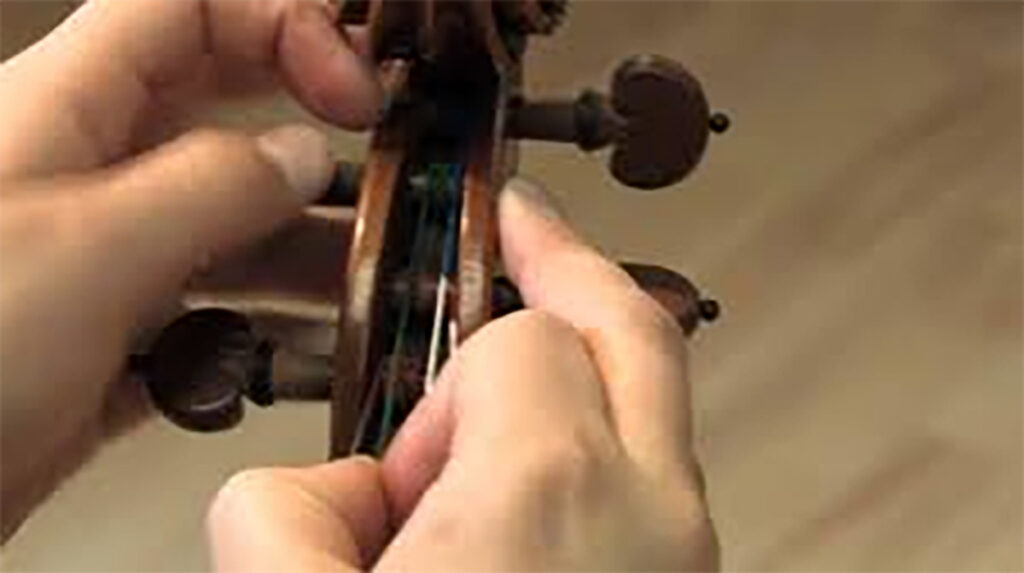When you put a new set of violin strings on your violin, even when they are the same exact brand, it can be quite astonishing (in a happy way), how much better your violin will sound and how better you will play. The new high end synthetic strings, like the Evah Pirazzi Gold, or Thomastik Peter Infeld, have almost no ‘break in’ time. Some of the ‘difficult’ passages suddenly ‘sound’ and the notes ‘pop’ out so much easier. Also, you’ll notice how much easier it is to get the notes to respond etc… One of the most important factors that explain this, that string wear out so gradually, from hours and hours of playing, daily, weeks, month and so on, it is just incredibly hard to remember how much better they were before (while new). Once the new ones are on, it’s an eye opening experience.

There are several factors when weighing what causes a string to break down. First, there’s the actual materials the string is made from: steel core, synthetic core, or even gut. Then, what are they wrapped with? Tungsten, aluminum, silver etc… While steel is by far the longest lasting, the sound not nearly as good as say with a more expensive synthetic material or for that matter, gut. Softer materials like gut sound great on a violin, but they are the most expensive and wear down the fastest because they are softer, or easier to damage. Some strings (like gut!) can actually break JUST from a sudden weather change, while it is still in the case!
So steel lasts the longest, but not nearly the best sounding. Gut, while some of the newest brands still use gut (even though it is a ‘old’) material, they too can break while playing or just get ‘tired’ and wear out. Synthetic strings are great because they will not breakdown as quickly or as violently as a gut string, but have a very responsive, warm tone.
How much playing and how hard do you play? Again, because of the super slow decay, even professional violinists sometimes (often) cannot really tell how bad the state of their strings are because it is so slow usually, you can see or hear in short time periods, but many know with say, a heavy orchestra schedule, of playing 7-9 rehearsals/concerts a week, that if they just remember to switch out their old set for new, every 6 months, they’re fine. Other factors come into ‘play’: Got an important performance coming up? A recital, a few days or a week before that big day. Same with an important audition. An interesting side note here is that you might even want to change to new strings even during the preparation (practice) time weeks BEFORE the audition or performance, because old tired strings will make you believe and/or think that it is YOU and not the string’s slow response keeping you from hearing exactly as you wish or know it should sound like.
Also, players that play more aggressively or over play, will and can wear out a set of good violin strings in half the time.
Set up and issues with the violin can also cause string to prematurely wear or break.
If you are seeing your strings wear out near the nut (by the scroll), where the string is unraveling or you can see a noticeable ‘ding’ there, have your luthier/violin repairman have a look at the nut grooves are not too narrow or pinching the string there. If it is pinching the string (too narrow) to let the string glide freely with tuning, it will quickly start to pull the outer winding apart at the nut. Same with the bridge grooves. Make sure that there is nothing that is sharp there or too narrow.
Why do A strings wear out sooner than the other 3 strings? When players (usually professional) buy new whole sets, they will often buy a 2nd new A string of the same brand and thickness.
A strings are usually made in aluminum. Aluminum is softer and therefore will ‘go’ before a silver one will. Additionally, because the A string is between two others (D and E) the player is just not able to switch a more pressing angle (like he can on a G or E) without having another neighboring string to accidentally run into (or bow) at the same time. So again, A’s wear out quicker because they are usually made from softer materials and can be player much harder than the others because of how they are positioned in relation to the neighboring strings.
Call Us
Head Office:
String Emporium, LLC
5561 W. Megan Street
Chandler, AZ 85226 USA
Working Days: Mon – Fri
Working Hours: 10 am to 6 pm
Fax: 480-705-9647
Email: info@violin-strings.com
Website: www.violin-strings.com
© 2025 String Emporium (violin-strings.com). All rights reserved. Privacy Policy